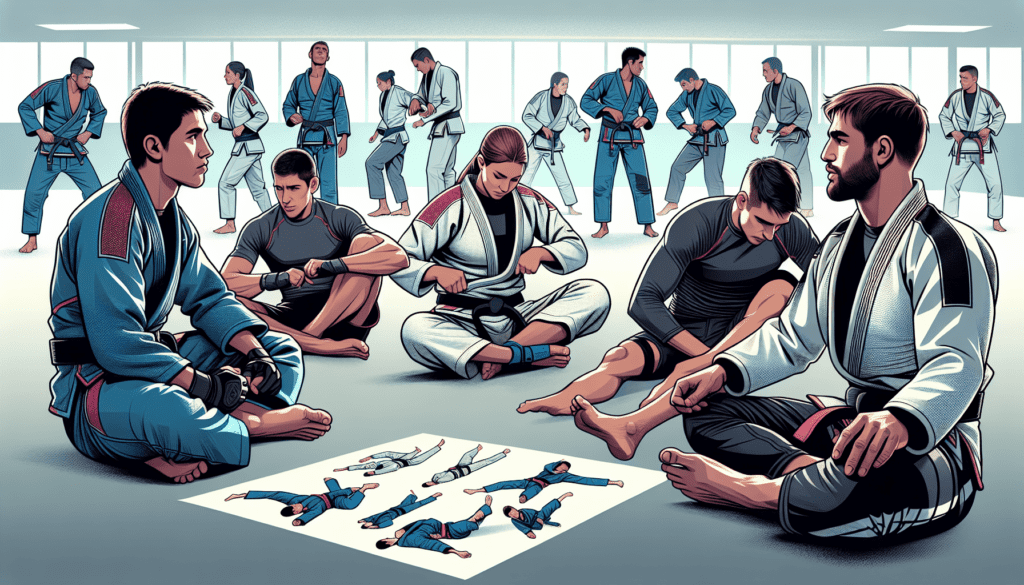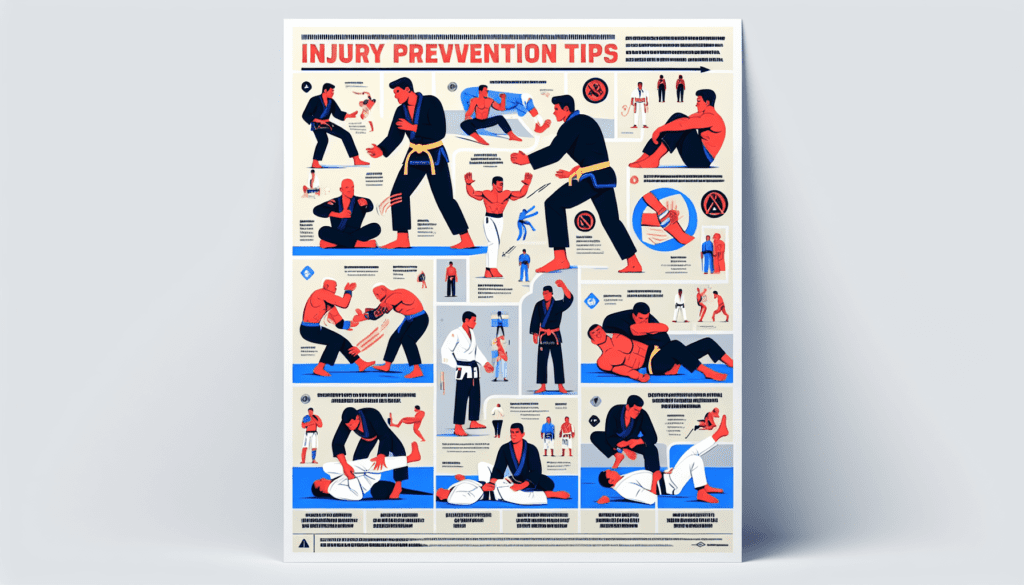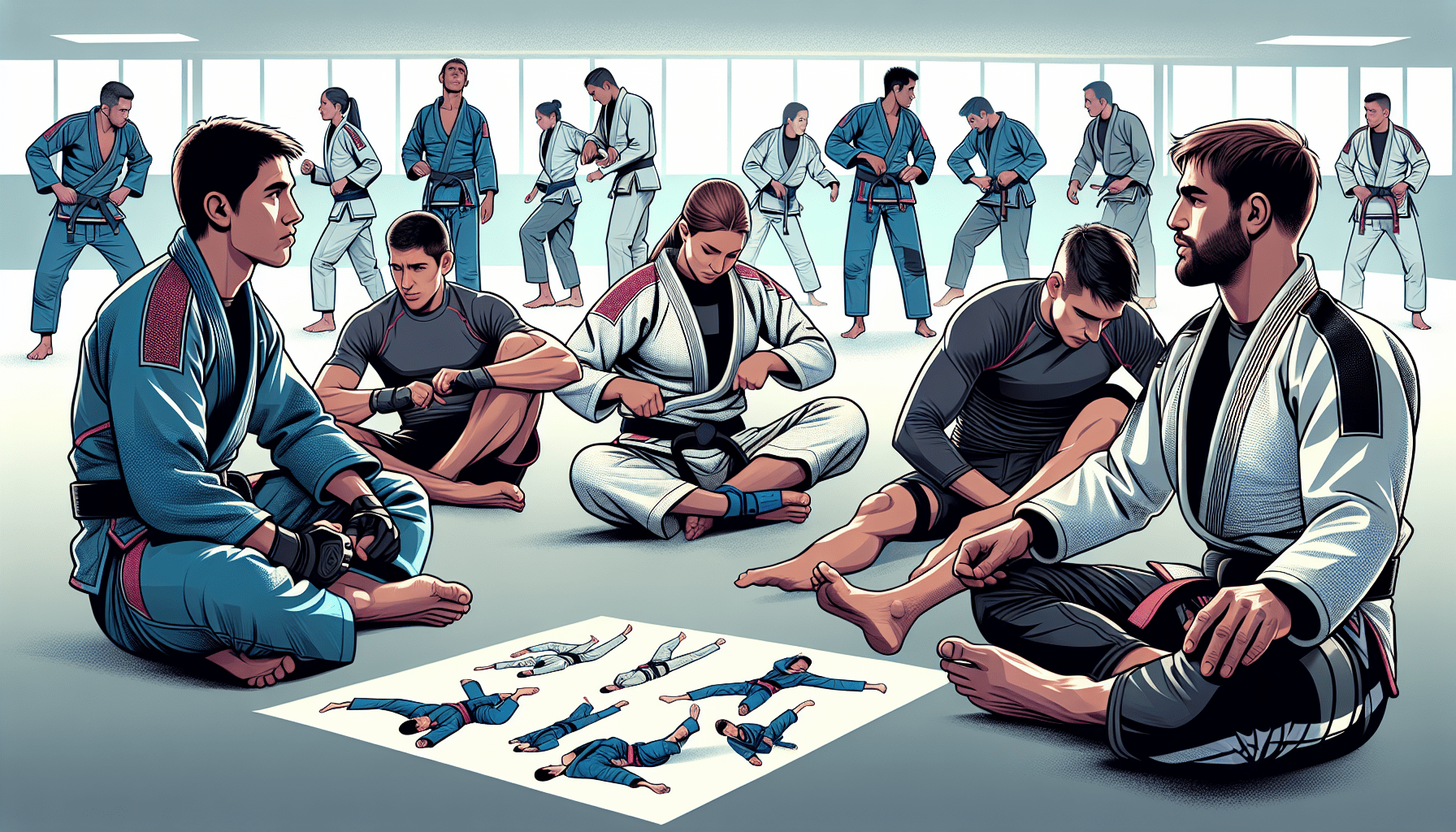Are you passionate about the world of grappling and Jiu Jitsu? If so, you know that while these martial arts can be exhilarating and rewarding, they also come with a risk of injury. But don’t worry, we’ve got you covered! In this article, you’ll find some invaluable injury prevention tips to help you stay healthy and minimize the chances of getting hurt during your grappling and Jiu Jitsu sessions. So, let’s dive right in and discover how you can protect yourself while pursuing your passion for these incredible martial arts!
Warm-Up Exercises
Importance of warm-up
Before engaging in any physical activity, including grappling and Jiu Jitsu, it is crucial to perform warm-up exercises to prepare your body for the intense training ahead. Warm-up exercises increase your heart rate, improve blood flow to the muscles, and enhance flexibility, which can help prevent injuries.
Dynamic stretches
Dynamic stretches are an essential part of your warm-up routine for grappling and Jiu Jitsu. Unlike static stretching, which involves holding a stretch for an extended period, dynamic stretches involve moving parts of your body through a full range of motion. These stretches help increase your range of motion, activate the muscles, and improve coordination and agility.
Dynamic stretches for grappling and Jiu Jitsu may include leg swings, arm circles, walking lunges, and torso twists. Performing these dynamic stretches before your training sessions can help prepare your muscles and joints for the physical demands of grappling, reducing the risk of injury.
Joint mobility exercises
In addition to dynamic stretches, incorporating joint mobility exercises into your warm-up routine is essential for grappling and Jiu Jitsu. These exercises involve moving your joints through their full range of motion, promoting joint health, and reducing the risk of injury.
Joint mobility exercises for grappling and Jiu Jitsu may include shoulder circles, hip circles, wrist rotations, and ankle circles. By warming up your joints properly, you can improve their flexibility and mobility, allowing you to perform grappling techniques more effectively and safely.
Proper Technique and Form
How technique affects injury risk
Proper technique and form are paramount in grappling and Jiu Jitsu, as they play a significant role in reducing the risk of injuries. By executing techniques with correct form, you distribute the forces evenly throughout your body, minimizing the impact on vulnerable areas.
Using improper technique can lead to strained muscles, twisted joints, and even serious injuries. It is essential to focus on learning and practicing the correct technique for each move under the guidance of a qualified instructor to ensure your safety and longevity in the sport.
Importance of practicing correct form
Consistently practicing correct form and technique is essential for grapplers and Jiu Jitsu practitioners. By doing so, you develop muscle memory and reinforce safe movement patterns. Practicing with proper form helps to improve your performance, enhance your efficiency, and reduce the risk of injury.
Whether you are a beginner or an experienced grappler, dedicating time to perfecting your technique is crucial. Regularly reviewing and refining your form not only improves your overall skill level but also helps prevent unnecessary strain on your body, reducing the likelihood of injuries.
Getting expert guidance
To ensure proper technique and form, it is highly recommended to seek guidance from qualified instructors or coaches. Their expertise and experience can help you understand the intricacies of each technique, correct any errors, and provide personalized feedback.
Instructors can also design training programs that cater to your skill level and goals while considering injury prevention. Their guidance can help you progress safely and minimize the risk of overuse injuries, ensuring a long and fulfilling journey in the world of grappling and Jiu Jitsu.

Strength and Conditioning
Benefits of strength training
Incorporating strength training into your grappling and Jiu Jitsu routine offers numerous benefits. Increased strength not only enhances your overall performance but also helps protect your joints and muscles from injuries.
By developing a strong core, upper body, and lower-body strength, you can improve your ability to execute techniques effectively and reduce the strain on your joints. Additionally, a solid strength training program can aid in injury prevention, as stronger muscles and connective tissues are less prone to strains and tears.
Exercises for grappling and Jiu Jitsu
When it comes to strength training for grappling and Jiu Jitsu, focusing on functional movements and compound exercises is key. These exercises engage multiple muscle groups simultaneously, mimicking the demands of grappling and Jiu Jitsu techniques.
Examples of exercises beneficial for grapplers and Jiu Jitsu practitioners include squats, deadlifts, lunges, push-ups, pull-ups, and core exercises like planks and Russian twists. It is important to consult with a strength and conditioning professional to design a training program tailored to your specific needs and goals.
Balancing strength and flexibility
While developing strength is important, it is equally important to maintain flexibility for optimal performance and injury prevention in grappling and Jiu Jitsu. Balancing strength and flexibility allows for fluid movement, agility, and quick transitions during training sessions and competitions.
Incorporating flexibility training exercises into your routine, such as static stretching and yoga, can help improve your range of motion and prevent muscle imbalances. By addressing both strength and flexibility, you can enhance your overall performance and reduce the risk of injuries during grappling and Jiu Jitsu activities.
Flexibility Training
Importance of flexibility in grappling
Flexibility plays a significant role in grappling and Jiu Jitsu. Having a higher degree of flexibility allows you to move more freely, perform techniques with greater precision, and reduce the risk of strains and muscle imbalances.
In grappling, being flexible enables you to achieve more dominant positions, execute submissions with efficiency, and defend against opponents’ attacks effectively. It also helps prevent overstretching or tearing of muscles during training or competitions.
Effective stretching exercises
Incorporating various stretching exercises into your training routine can help improve your flexibility for grappling and Jiu Jitsu. Static stretching, which involves holding a stretch for a specific period, can be beneficial after your training sessions to help elongate the muscles and improve flexibility over time.
Key stretches for grapplers and Jiu Jitsu practitioners include hamstring stretches, hip openers, shoulder stretches, and neck stretches. It is important to listen to your body, not force any stretches, and gradually increase the intensity and duration of your stretching routine.
Incorporating mobility drills
In addition to stretching exercises, incorporating mobility drills into your training can help improve flexibility and overall movement quality. Mobility drills involve moving a joint or a sequence of joints through their full range of motion, improving joint health and functional mobility.
Mobility drills specific to grappling and Jiu Jitsu may include hip rotations, shoulder dislocations, scapular retractions, and thoracic spine rotations. Implementing these drills before and after training sessions can enhance your flexibility and mobility, reducing the risk of injuries while grappling.

Grip Strength
The role of grip strength in grappling
Grip strength is a vital component of grappling and Jiu Jitsu. Having a strong grip allows you to secure and control your opponent, execute techniques with precision, and defend against various grips and holds.
Strong grip strength not only improves your overall grappling performance but also reduces the risk of injuries. A weak grip can lead to compromised positions or premature release of holds, potentially resulting in strained fingers, wrists, or forearms.
Exercises to improve grip strength
There are several exercises you can incorporate into your training routine to develop grip strength specifically for grappling and Jiu Jitsu.
Deadlifts, farmer’s walks, pull-ups, and towel pull-ups are excellent compound exercises that engage your grip muscles. Additionally, using grip-specific training tools like grip trainers or grip balls can help target and strengthen the muscles responsible for a strong grip.
Hand and forearm conditioning
In addition to grip strength exercises, it’s important to incorporate hand and forearm conditioning exercises into your training routine. These exercises help toughen the muscles and tissues in your hands and forearms, preventing injuries such as sprains or strains.
Some common hand and forearm conditioning exercises for grappling and Jiu Jitsu include wrist curls, wrist extensions, finger push-ups, and rice bucket exercises. Gradually increasing the intensity and duration of these exercises can help build resilience in your hands and forearms, reducing the risk of injury during grappling sessions.
Injury Awareness and Prevention
Understanding common grappling injuries
Being aware of common grappling injuries is crucial for injury prevention and early intervention. While injuries can vary, common grappling injuries include sprained joints, muscle strains, ligament tears, and joint dislocations.
Understanding the mechanisms behind these injuries, such as excessive joint pressure or sudden twists, can help you identify potential risk factors and take necessary precautions to minimize the risk of injury during training sessions or competitions.
Recognizing early signs of injury
Recognizing the early signs of injury is essential for prompt intervention and prevention of further damage. Pain, swelling, stiffness, and decreased range of motion are common indicators that an injury may be developing.
If you experience any of these signs, it is important to listen to your body and take appropriate action. Resting, applying ice, and seeking professional medical advice can help prevent minor issues from developing into more severe injuries that may require extended recovery periods.
Preventive measures like taping and bracing
In addition to awareness and early recognition, utilizing preventive measures like taping or bracing can help reduce the risk of grappling-related injuries. Taping vulnerable areas, such as the fingers, wrists, or ankles, can provide additional support and stability during training sessions.
Bracing certain joints or using specialized protective gear, such as knee braces or mouthguards, can also provide added protection against impact or strain. Discussing these preventive measures with a qualified sports medicine professional can help you determine the most suitable options for your grappling and Jiu Jitsu activities.
Rest and Recovery
Importance of rest and recovery
Rest and recovery are essential components of any training program, including grappling and Jiu Jitsu. Adequate rest allows your body to repair and rebuild tissues, replenish energy stores, and adapt to the demands placed on it during training.
Without sufficient rest, overtraining and fatigue can occur, increasing the risk of injuries and diminishing performance. It is important to prioritize rest and recovery between training sessions to maximize the benefits of your training and prevent burnout.
Balancing training intensity and rest days
Finding the right balance between training intensity and rest days is crucial for injury prevention and optimal performance. Gradually increasing training intensity and volume while allowing for regular rest days is key to avoiding overuse injuries.
Strive for a training schedule that incorporates both intense sessions and lighter training days or active recovery activities to give your body enough time to recover and adapt. Planning rest days strategically can help prevent accumulated fatigue and reduce the risk of injuries associated with overtraining.
Incorporating active recovery techniques
Active recovery techniques can be beneficial for grapplers and Jiu Jitsu practitioners as they promote blood flow, muscle relaxation, and mobility without causing excessive stress on the body. These techniques can include low-intensity exercises like walking, swimming, or light stretching.
Incorporating foam rolling or using massage tools can also help alleviate muscle soreness and improve recovery. It is important to listen to your body and adjust the intensity and duration of active recovery activities based on your individual needs and recovery rate.
Nutrition and Hydration
Importance of proper nutrition
Proper nutrition plays a vital role in injury prevention and overall performance in grappling and Jiu Jitsu. Consuming a well-balanced diet that provides adequate macronutrients (carbohydrates, proteins, and fats) and micronutrients (vitamins and minerals) can support optimal health and recovery.
A balanced diet can help maintain muscle strength, enhance energy levels, and support the immune system, reducing the risk of injuries and promoting overall well-being.
Key nutrients for recovery and injury prevention
Certain nutrients are particularly important for grapplers and Jiu Jitsu practitioners due to the physical demands of the sport. Consuming sufficient protein promotes muscle repair and growth, while carbohydrates provide energy for intense training sessions.
Omega-3 fatty acids, found in fish and flaxseed, have anti-inflammatory properties that can aid in recovery and reduce joint inflammation. Adequate intake of calcium, magnesium, and vitamin D helps support bone health and prevent fractures.
Hydration guidelines for grapplers
Proper hydration is vital for grapplers and Jiu Jitsu practitioners to maintain optimal performance and prevent dehydration-related complications. It is essential to hydrate adequately before, during, and after training sessions or competitions.
The American College of Sports Medicine recommends drinking approximately 16-20 ounces of water 2 hours before exercise and 7-10 ounces every 10-20 minutes during exercise. Monitoring urine color can also be a useful indicator of hydration status – pale yellow to clear urine suggests proper hydration.
Safe Sparring Practices
Setting guidelines for sparring sessions
Safe sparring practices are critical in grappling and Jiu Jitsu to reduce the risk of injuries. Establishing clear guidelines and rules for sparring sessions helps create a safe and respectful training environment.
Setting limits on the intensity and duration of sparring bouts, creating a culture of respect and sportsmanship, and emphasizing the importance of communication can all contribute to safer sparring sessions.
Importance of communication and signaling
Clear communication between training partners is crucial during sparring sessions. Verbal cues or signals can help indicate when a technique is too intense or when a participant needs a break or adjustment.
Encouraging open communication and providing opportunities for feedback during training can create a more collaborative and safe environment for all practitioners.
Avoiding excessive force and ego-driven behavior
Avoiding excessive force and ego-driven behavior is essential for injury prevention in grappling and Jiu Jitsu. It is important to approach training sessions with a mindset focused on skill development and mutual growth, rather than trying to overpower or prove oneself.
Respecting the boundaries and limitations of training partners, and avoiding unnecessary aggression or force, can contribute to a safer training environment and reduce the risk of injuries.
Injury Management
Immediate steps after an injury
In the unfortunate event of an injury during grappling or Jiu Jitsu, it is crucial to take immediate steps to prevent further harm and promote recovery. First and foremost, stop the activity that caused the injury and rest the affected area.
Applying ice to reduce swelling and elevating the injured limb can help manage pain and inflammation. Avoiding additional stress on the injured area and seeking professional medical evaluation are also important early steps in injury management.
Seeking medical attention
For more severe injuries or injuries that do not improve with initial self-care measures, it is essential to seek professional medical attention. Medical professionals, such as sports medicine physicians or orthopedic specialists, can assess the extent of the injury, provide an accurate diagnosis, and recommend appropriate treatment options.
Timely medical intervention and following a comprehensive rehabilitation program can help optimize recovery and prevent long-term complications.
Rehabilitation and returning to training safely
Rehabilitation is a critical phase in the recovery process after grappling or Jiu Jitsu injuries. Working with qualified healthcare professionals, such as physical therapists or athletic trainers, can help design a personalized rehabilitation program focused on restoring function, strength, and mobility.
Gradually returning to training after an injury is crucial to prevent re-injury. It is important to follow the guidance of healthcare professionals and gradually increase the intensity and duration of training sessions, ensuring that the injured area has fully healed and regained its strength.
By prioritizing proper technique, incorporating strength and flexibility training, practicing injury prevention strategies, and allowing for sufficient rest and recovery, you can minimize the risk of grappling and Jiu Jitsu-related injuries. Remember, a holistic approach that includes proper nutrition, hydration, and safe training practices is key to maintaining a healthy and successful grappling journey. So, stay safe, listen to your body, and enjoy the adventurous world of grappling and Jiu Jitsu!

